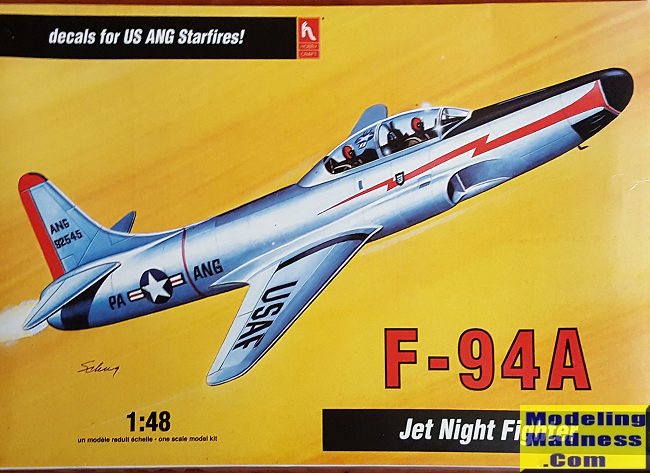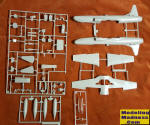
Hobbycraft 1/48 F-94A Starfire
| KIT #: | HC 1597 |
| PRICE: | $17.00 to my door [used] |
| DECALS: | Two options |
| REVIEWER: | Scott Van Aken |
| NOTES: | 1992 release |

| HISTORY |
Built to a 1948 USAF specification for a radar-equipped interceptor to replace the aging F-61 Black Widow and North American F-82 Twin Mustang, it was specifically designed to counter the threat of the USSR's new Tupolev Tu-4 bombers (reverse-engineered Boeing B-29). The Curtiss-Wright XF-87 Blackhawk had been designated to be the USAF first jet night fighter, but its performance was subpar, and Lockheed was asked to design a jet night fighter on a crash program basis. The F-94 was derived from the TF-80C (later T-33A Shooting Star) which was a two-seat trainer version of the F-80 Shooting Star. A lengthened nose area with guns, radar, and automatic fire control system was added. Since the conversion seemed so simple, a contract was awarded to Lockheed in early 1949, with the first flight on 16 April 1949. The early test YF-94s used 75% of the parts used in the earlier F-80 and T-33As.
The fire control system was the Hughes E-1, which incorporated an AN/APG-33 radar (derived from the AN/APG-3, which directed the Convair B-36's tail guns) and a Sperry A-1C computing gunsight. This short-range radar system was useful only in the terminal phases of the interception. Most of the operation would be directed using ground-controlled interception, as was the case with the earlier aircraft it replaced.
The added weight of the electronic equipment required a more powerful engine, so the standard J-33 turbojet engine, which had been fitted to the T-33A, was replaced with an afterburning Allison J33-A-33. The combination reduced the internal fuel capacity. The F-94 was to be the first US production jet with an afterburner. The J33-A-33 had standard thrust of 4,000 pounds-force (18 kN), and with water injection this was increased to 5,400 pounds-force (24 kN) and with afterburning a maximum of 6,000 pounds-force (27 kN) thrust. The YF-94A's afterburner had many teething problems with its igniter and the flame stabilization system.
The initial production model was the F-94A, which entered operational service in May 1950. Its armament was four 0.50 in (12.7 mm) M3 Browning machine guns mounted in the fuselage with the muzzles exiting just behind the radome. Two 165 US Gallon (1,204 litre) drop tanks, as carried by the F-80 and T-33, could be carried beneath the wingtips. Alternatively, these could be replaced by 1,000 lb (454 kg) bombs, giving the aircraft a secondary fighter bomber role. 109 were produced. The F-94A was in operational service for only a brief time as it was originally built, and was not received well by its aircrews. Primarily, this was due to the unreliability of its J33 engine, which caused many ground aborts and was deemed by the crews to be unsafe. The aircraft was judged as unstable and hard to maneuver at high altitude by its pilots. The pilot and radar operator found that the cockpit was too narrow for them to be able to get in and out of the aircraft quickly during alerts and scrambles. The clearance for the ejection seats was too small, resulting in several tragic accidents during emergency ejections.| THE KIT |
 Back
when HobbyCraft released their T-33s, modelers were hoping they would also do
the early F-94s. These were planes that were not available anywhere in 1/48 from
a standard manufacturer, and are still the only kits available. These were boxed
both as the A and B versions as they are, for most purposes, externally
identical.
Back
when HobbyCraft released their T-33s, modelers were hoping they would also do
the early F-94s. These were planes that were not available anywhere in 1/48 from
a standard manufacturer, and are still the only kits available. These were boxed
both as the A and B versions as they are, for most purposes, externally
identical.
This kit is the A version and not surprisingly, it uses several sprues from their T-33 kit. Those that are different are the two fuselage halves, a sprue with wing tips and the early tanks that hang from them as well as an area on the main sprue that has bits for the rear seat radar operator's equipment.
The rest is the same. The kit has a main gear well insert and separate wheel well. The cockpit is fairly well appointed, though it could benefit from a replacement as could the seats, but for most modelers they are fine. There are separate flaps so you can pose those lowered. Landing gear are also well done and the canopy is separate from the windscreen so you can pose that open as well.
 Instructions
are adequate to build the kit will nicely done drawings and color information in
generic and FS 595 references. The decals, however, are Hobbycraft's early ones
and to put it mildly, they are horrible. My experiences with early boxings is
that the decals will not stick to the model. To make matters worse, the font is
wrong, basically being too skinny. Markings are for the box art plane from the
PA ANG and another with yellow and blue fuselage and tail stripes from an
unknown unit. Now for the really bad news. No one of whom I am aware, makes
F-94A aftermarket decals in this scale. The best you can hope for is to get an
F-94B sheet for the insignia and common markings and somehow coax the kit
markings into submission by immersing them in Future prior to application
(assuming they don't fall apart when you get them wet).
Instructions
are adequate to build the kit will nicely done drawings and color information in
generic and FS 595 references. The decals, however, are Hobbycraft's early ones
and to put it mildly, they are horrible. My experiences with early boxings is
that the decals will not stick to the model. To make matters worse, the font is
wrong, basically being too skinny. Markings are for the box art plane from the
PA ANG and another with yellow and blue fuselage and tail stripes from an
unknown unit. Now for the really bad news. No one of whom I am aware, makes
F-94A aftermarket decals in this scale. The best you can hope for is to get an
F-94B sheet for the insignia and common markings and somehow coax the kit
markings into submission by immersing them in Future prior to application
(assuming they don't fall apart when you get them wet).
| CONCLUSIONS |
So there you have it. The model will build up into something nice for your shelf and for your 50s fighter collection, but you will have to do some scrounging to get proper markings for your project.
| REFERENCES |
https://en.wikipedia.org/wiki/Lockheed_F-94_Starfire
November 2017 Copyright ModelingMadness.com.
All rights reserved. If you would like your product reviewed fairly and fairly quickly, please contact the editor or see other details in the
Note to
Contributors. Back to the Main Page
Back to the Review
Index Page
Back to the Previews Index Page